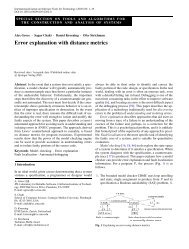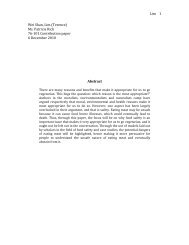A refactored proof of conceptual completeness
A refactored proof of conceptual completeness
A refactored proof of conceptual completeness
Create successful ePaper yourself
Turn your PDF publications into a flip-book with our unique Google optimized e-Paper software.
this is equivalent to an element aH ∈ A MH .<br />
(−)×A<br />
MH<br />
<br />
<br />
<br />
E Th(M)<br />
˜∗ <br />
<br />
<br />
<br />
ã<br />
<br />
H<br />
E/A<br />
MaH <br />
<br />
Sets <br />
From this we can define a family <strong>of</strong> functions hA : A M → A MH by setting<br />
hA(a) = aH. If σ M (b) = a then ˜ b ◦ σ ∗ = ã. Consequently<br />
H ◦ ã = H ◦ ˜ b ◦ σ ∗ = MbH ◦ σ∗ = MaH .<br />
This ensures that hA ◦ σ M = σ MH ◦ hB, so that h is a natural transformation.<br />
Thus the Th(M)-model H defines a model homomorphism h : M → MH. In<br />
fact, this construction is reversible: h is sufficient to construct H.<br />
Moreover, a natural transformation θ : H → K induces a homomorphism<br />
MH → MK which commutes with the maps from M. This leaves us with the<br />
following:<br />
Proposition 2.1. Th(M) classifies E-models under M. If H : Th(M) → Sets,<br />
H ◦ ˜∗ defines a model MH and the assignment h(a) = c H a defines an E-model<br />
homomorphism h : M → MH.<br />
3 Connecting syntax and semantics<br />
In this section we will show that certain semantic properties <strong>of</strong> interpretations<br />
I : E → F naturally correspond dual properties for the functors I∗ : Mod(E) →<br />
Mod(F). Specifically, we will prove the theorem below (definitions to follow).<br />
Theorem 3.1.<br />
(a) I is conservative if and only if I ∗ is supercovering.<br />
(b) I is full on subobjects if and only if I ∗ stabilizes subobjects.<br />
(c) I is subcovering if and only if I ∗ is faithful.<br />
6








